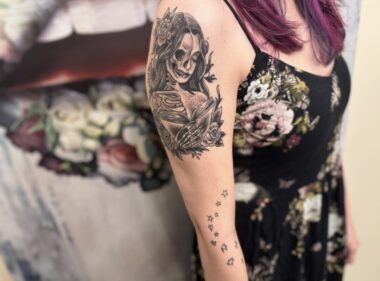How I’m safely reconnecting with my body through tattoos
I came up with a good plan with my medical team and tattoo artist

Having a rare disease means I have a complicated relationship with my body. I cycle through anger — wishing away my medical problems or my staggering medical bills — and the empathy that comes with knowing that teenage me navigated my medical journey the best I could. After turning 40 last year, I challenged myself to find new ways to love my body, hypoparathyroidism and all.
I’d told myself “no” for so long about so many things, which were boundaries I’d built after being at my worst. Since starting the hypopara treatment Yorvipath (palopegteriparatide), I’ve been striving to reexamine my old limits and long-held beliefs about what I can and can’t do. I began traveling more, working toward bigger career goals, and crossing off items on my bucket list.
One of those items was more tattoos!
Tattoos are a form of self-expression that I’ve always been drawn to. I keep a giant photo album and lists of pieces I love. The ache of wanting to expand the art from inside my head to on my body grew until one day I finally decided it was time to do something about it.
But was it possible? Was my consistent “NO!” due to anxiety or a health boundary?
Turns out, it was a little of both.
Twenty years ago, I’d gotten a black-ink tattoo on my foot without much forethought. This ended up being a touchpoint for my research. The tattoo healed well, and I had no negative reactions.
After talking to other hypopara patients with tattoos, I met with my medical team, including my primary care physician, dermatologist, and endocrinologist. We talked over potential concerns, like hypopara-related skin conditions such as eczema, and frequent side effects like muscle spasms. After getting my doctors’ notes, I found a local shop recommended by multiple friends and had an in-person consultation.
My medical team and tattoo artist came up with a concise plan:
- Black ink only. We know I can tolerate it and other colors can be more likely to cause allergic reactions.
- No tattoos over areas currently in spasm (like my haunted left arm).
- Avoid tattoos on my inner left arm, where I most often have blood drawn (to avoid complications).
- No tattoos on my inner, upper thighs, where I inject my medication (to avoid complications).
- No physical therapy or massage on the tattooed area for at least 10 days, which limits placement options.
From there, it came down to design. I started small and easy. I’ve learned that I have mild side effects after an appointment, including fatigue, headache, and nausea. The intensity of the side effects increases with a piece’s size and the amount of ink used. A simple sketch tattoo that took 20 minutes barely fazed me, while my large, detailed shoulder piece required multiple days of recovery. I’m lucky that all my tattoos have healed well with no complications.

Heather Novak shows off two of her tattoos, one large and intricate and the other a simple outline. (Courtesy of Heather Novak)
Throughout this journey, I’ve added to my plan:
- Get calcium labs a few days before and only get a tattoo if I’m stable and in range.
- Take my emergency anti-anxiety medication (lorazepam). This keeps me from tensing and potentially having a muscle spasm and prevents a panic attack that could lead to lower calcium levels.
- Bring a friend who can drive and knows what to do in an emergency medical situation. (I don’t drive after taking lorazepam.)
- Pack a tattoo bag with a small, battery-operated fan for anxiety sweats, emergency chewable calcium, EpiPens, an asthma inhaler, a granola bar, peppermint candy, and a large water.
- Communicate! My artist can’t read my mind. White-knuckling through it isn’t always the answer, and sometimes I need to move around and take a water break to calm down my muscles.
- Respect my body. Even when I book an appointment weeks in advance and am really excited, hard hypopara days are not good tattoo days. Luckily, my artist is flexible with my needs and rescheduling has never been an issue.
- Make sure the design is one I want to look at daily and does not negatively affect my mental health.
I’m in the United States, and my tattoo experience and knowledge is limited to this country’s mainstream tattoo culture. Tattoos are not right for everyone. There are both short- and long-term risks, some of which are still being studied.
Despite the risks, I’m very happy I faced my fears and did the research. After years of feeling disconnected from a body that felt like a stranger’s, my tattoos have allowed me to reconnect with myself in a beautiful way. With my new ink, I feel like I’m evolving into the person I’m striving to be: someone who feels at home in their body and loves it, hypopara and all.
Note: Hypoparathyroidism News is strictly a news and information website about the disease. It does not provide medical advice, diagnosis, or treatment. This content is not intended to be a substitute for professional medical advice, diagnosis, or treatment. Always seek the advice of your physician or another qualified health provider with any questions you may have regarding a medical condition. Never disregard professional medical advice or delay in seeking it because of something you have read on this website. The opinions expressed in this column are not those of Hypoparathyroidism News or its parent company, Bionews, and are intended to spark discussion about issues pertaining to hypoparathyroidism.








Leave a comment
Fill in the required fields to post. Your email address will not be published.